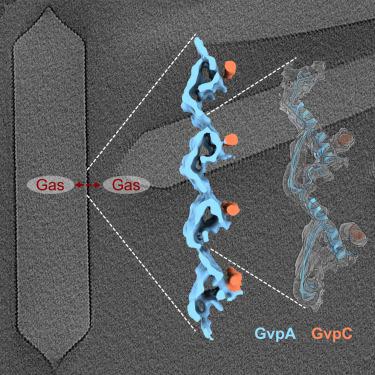Structure ( IF 4.4 ) Pub Date : 2023-04-10 , DOI: 10.1016/j.str.2023.03.011 Przemysław Dutka 1 , Lauren Ann Metskas 2 , Robert C Hurt 2 , Hossein Salahshoor 3 , Ting-Yu Wang 4 , Dina Malounda 5 , George J Lu 5 , Tsui-Fen Chou 4 , Mikhail G Shapiro 6 , Grant J Jensen 7

|
Gas vesicles (GVs) are gas-filled protein nanostructures employed by several species of bacteria and archaea as flotation devices to enable access to optimal light and nutrients. The unique physical properties of GVs have led to their use as genetically encodable contrast agents for ultrasound and MRI. Currently, however, the structure and assembly mechanism of GVs remain unknown. Here we employ cryoelectron tomography to reveal how the GV shell is formed by a helical filament of highly conserved GvpA subunits. This filament changes polarity at the center of the GV cylinder, a site that may act as an elongation center. Subtomogram averaging reveals a corrugated pattern of the shell arising from polymerization of GvpA into a β sheet. The accessory protein GvpC forms a helical cage around the GvpA shell, providing structural reinforcement. Together, our results help explain the remarkable mechanical properties of GVs and their ability to adopt different diameters and shapes.
中文翻译:

cryo-ET 揭示的鱼腥藻气囊结构
气囊 (GV) 是一种充满气体的蛋白质纳米结构,被多种细菌和古细菌用作漂浮装置,以获取最佳的光照和营养。GV 的独特物理特性导致它们被用作超声和 MRI 的基因编码造影剂。然而,目前,GV 的结构和组装机制仍然未知。在这里,我们使用低温电子断层扫描来揭示 GV 壳是如何由高度保守的 GvpA 亚基的螺旋丝形成的。该灯丝改变 GV 圆柱中心的极性,该位置可能充当伸长中心。子断层图平均揭示了由于 GvpA 聚合成 β 折叠而产生的壳波纹图案。辅助蛋白 GvpC 在 GvpA 外壳周围形成螺旋笼,提供结构加固。一起,











































 京公网安备 11010802027423号
京公网安备 11010802027423号